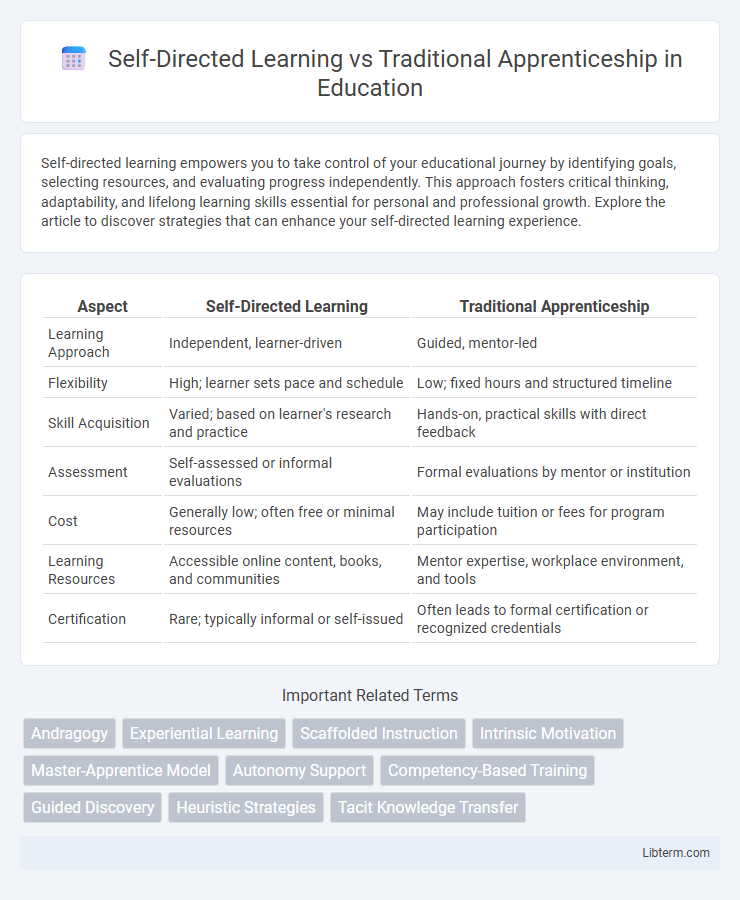Self-directed learning empowers you to take control of your educational journey by identifying goals, selecting resources, and evaluating progress independently. This approach fosters critical thinking, adaptability, and lifelong learning skills essential for personal and professional growth. Explore the article to discover strategies that can enhance your self-directed learning experience.
Table of Comparison
| Aspect | Self-Directed Learning | Traditional Apprenticeship |
|---|---|---|
| Learning Approach | Independent, learner-driven | Guided, mentor-led |
| Flexibility | High; learner sets pace and schedule | Low; fixed hours and structured timeline |
| Skill Acquisition | Varied; based on learner's research and practice | Hands-on, practical skills with direct feedback |
| Assessment | Self-assessed or informal evaluations | Formal evaluations by mentor or institution |
| Cost | Generally low; often free or minimal resources | May include tuition or fees for program participation |
| Learning Resources | Accessible online content, books, and communities | Mentor expertise, workplace environment, and tools |
| Certification | Rare; typically informal or self-issued | Often leads to formal certification or recognized credentials |
Introduction to Learning Pathways
Self-directed learning promotes autonomy by enabling individuals to tailor their education according to personal goals and pace, contrasting with traditional apprenticeships that emphasize guided, hands-on experience under expert supervision. Learning pathways in self-directed environments often utilize digital resources, allowing flexible, competency-based progression, while apprenticeship pathways rely on structured, time-bound skill mastery within real-world contexts. Both approaches develop critical skills, but self-directed learning fosters adaptability and lifelong learning habits, whereas apprenticeships provide deep industry-specific knowledge through direct mentorship.
Defining Self-Directed Learning
Self-directed learning is a learner-centered approach where individuals take initiative, set goals, identify resources, and evaluate their progress independently, contrasting with the structured guidance of traditional apprenticeship. This method emphasizes autonomy, critical thinking, and adaptability, empowering learners to tailor their educational journey according to personal interests and professional demands. Unlike apprenticeship, which relies on experiential learning under a mentor, self-directed learning fosters lifelong skills crucial in dynamic knowledge economies.
Understanding Traditional Apprenticeship
Traditional apprenticeship emphasizes hands-on experience under the guidance of a skilled mentor within a specific trade or craft, fostering practical skill acquisition through real-world application. This method integrates structured training schedules with progressive responsibility, allowing apprentices to learn industry standards and craftsmanship nuances over an extended period. Typically, traditional apprenticeship leads to certification or journeyman status, validating expertise and enhancing employability in specialized professions.
Key Differences Between the Two Approaches
Self-directed learning emphasizes autonomy, allowing individuals to set their own goals, select resources, and control the pace of learning, while traditional apprenticeship relies on structured, mentor-guided training within a specific trade or craft. Assessment in self-directed learning is often self-evaluated or project-based, contrasting with apprenticeship models that depend on direct supervision and performance feedback from experienced practitioners. The flexibility and customization in self-directed learning cater to personal development across diverse fields, whereas apprenticeships are typically time-bound programs focused on mastering particular skills through hands-on experience.
Benefits of Self-Directed Learning
Self-directed learning empowers individuals to tailor their education to personal goals, fostering greater motivation and engagement compared to traditional apprenticeship models. It enhances critical thinking, problem-solving skills, and adaptability by encouraging learners to take ownership of their knowledge acquisition. This approach offers flexibility in pace and content, making it ideal for evolving industries that demand continuous skill development.
Advantages of Traditional Apprenticeship
Traditional apprenticeship offers hands-on experience under the direct supervision of skilled professionals, fostering practical skills and industry-specific knowledge. This method provides structured learning pathways with immediate feedback and mentorship, enhancing skill retention and workplace readiness. Apprenticeships also facilitate networking opportunities and often lead to job placements within established companies.
Challenges and Limitations of Each Model
Self-directed learning often faces challenges such as lack of structured guidance, potential knowledge gaps, and difficulties in maintaining motivation and discipline without external accountability. Traditional apprenticeship models are limited by their dependence on the availability of skilled mentors, rigid hierarchical learning structures, and potential for outdated techniques persisting without innovation. Both models encounter barriers in measuring learner progress objectively and ensuring comprehensive skill acquisition in rapidly evolving industries.
Best Contexts for Each Learning Style
Self-directed learning thrives in contexts where learners seek flexibility, autonomy, and personalized pacing, such as online courses or independent projects in rapidly evolving fields like technology and creative arts. Traditional apprenticeship excels in hands-on, skill-intensive environments requiring direct mentorship and real-time feedback, including trades like carpentry, plumbing, and culinary arts. Each approach maximizes effectiveness when aligned with the learner's goals, industry demands, and the complexity of skills being acquired.
Integrating Both Approaches for Optimal Results
Integrating self-directed learning with traditional apprenticeship leverages the strengths of personalized, autonomous skill development alongside hands-on experience guided by expert mentorship. This hybrid approach fosters deeper mastery by combining theoretical knowledge acquisition with practical application in real-world settings. Employers and educators implementing blended models report enhanced learner engagement, faster competency attainment, and improved adaptability in diverse professional environments.
Conclusion: Choosing the Right Path
Choosing the right path between self-directed learning and traditional apprenticeship depends on individual goals, learning styles, and industry demands. Self-directed learning offers flexibility and fosters critical thinking, while traditional apprenticeships provide hands-on experience and mentorship. Evaluating personal preferences and career objectives ensures optimal skill development and professional growth.
Self-Directed Learning Infographic

 libterm.com
libterm.com